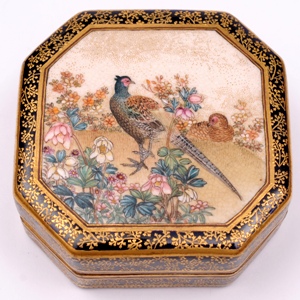There is often a perception that pottery is the poorer country relative to porcelain, but if you believe that you would be guilty of trying to compare oranges with apples. Some people may prefer the earthy charms of a country lass rather than the polished finish of a metropolitan socialite and to my mind the former can if necessary put on the airs and graces to get by in the smartest of circles. Certainly when Satsuma earthenware is at it’s best it can hold its head in any company.

A dramatically decorated, but unsigned Satsuma vase (FS18/500)
Satsuma was first produced in the late 16th century in Kagoshima province on the southern island of Kyushu, Japan its soft white appearance and crazed glazing quickly becoming popular. Named after the Prince of Satsuma production eventually moved to Kyoto in the 19th century and became very popular in Europe after the opening up of Japan and the subsequent 1873 Vienna World Fair.

A Satsuma box and cover by Kinkozan Sobei VI (FS18/498)
Unlike the sparse decoration on Kakiemon porcelain or Japanese woodblock prints, Satsuma is both richly gilt and profusely decorated, often the backgrounds being embellished with precise and minute dots. Perhaps the finest exponent of the art was Kinkozan Sobei VI who headed up one of the largest Satsuma manufactories in Kyoto. However, having extolled the virtues of Satsuma, even Kinkozan Sobei could be inconsistent though this was largely as a result of buying in undecorated blanks from elsewhere. So if I was to continue the metaphor I started with it would seem that even the sassy city lass could get caught with a pair of wellies getting as mucky as anyone else.

Signature of Kinkozan Sobei VI (FS18/498)







